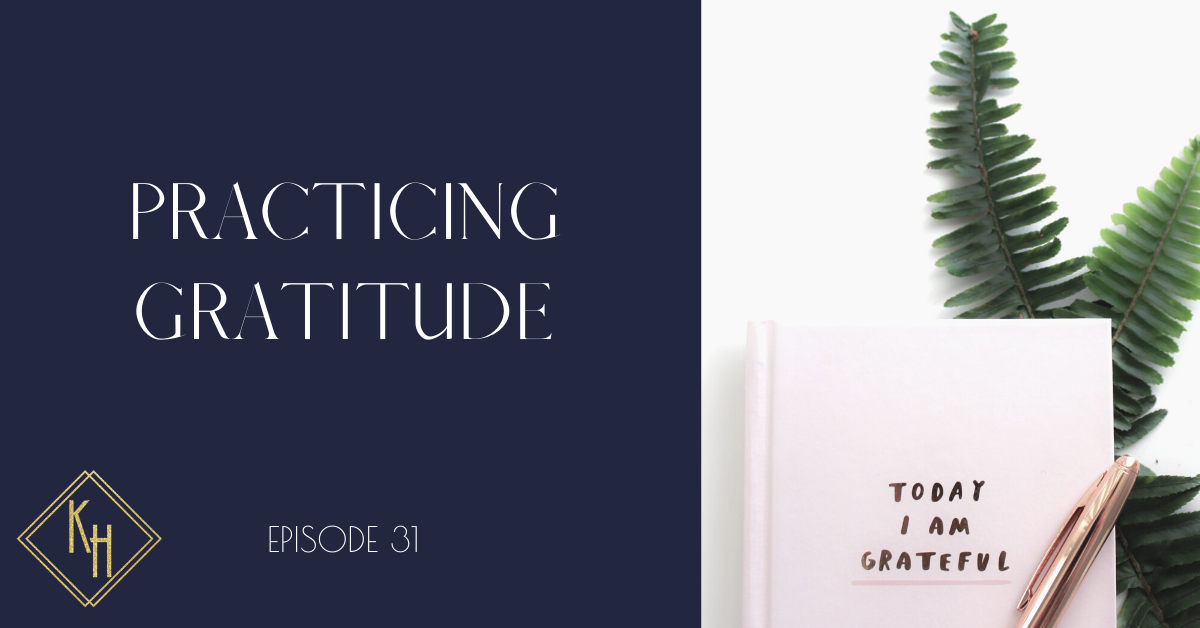Practicing Gratitude (RE-POST)
Photo by Gabrielle Henderson on Unsplash
“Reflect on your present blessings, of which every man has many, not on your past misfortunes, of which all men have some.”
-Charles Dickens
Prefer to listen?
This is typically a season of gratitude, yet I know several of us are struggling to practice it this year. We are worn down, frustrated, and worried. However, this frustration and weariness is exactly why I wanted to write this blog post. I want to invite you to take a step back – in fact, go grab a cup of coffee, sit down, and relax. Go ahead, I can wait.
Thanksgiving is just around the corner and if you’re anything like me, you recently realized that your children have the WHOLE WEEK off from school and you slightly panicked! I love my children but an entire week with them at home can be difficult. We have a lot more fun together when I’m not trying to be “super mom” and “employee of the year” at the same time – we learned that lesson during quarantine.
When faced with times like these – times when our two worlds of work and family inevitably collide – times when you feel stuck in between the demands of your job (and your desire to do a good job) and the demands of your family (and your desire to love, care for, and spend time with them), a really great exercise is to practice gratitude. This practice allows us to gain a fresh perspective on our situation and I’m sure many of you agree, we could all use this from time to time.
What is gratitude?
Gratitude doesn’t cleanly fit into just one box. It has been classified as an emotion, an attitude, a moral virtue, a personality trait, and a coping resource (Emmons & McCullough, 2003). Gratitude can be defined as “a generalized tendency to recognize and respond with grateful emotion to the roles of other people’s benevolence in the positive experiences and outcomes that one obtains” (McCullough et al., 2002, p. 112). In other words, gratitude stems from the recognition that we have received something positive, that wasn’t necessarily earned or deserved, from someone else. Synonyms for gratitude include gratefulness, thankfulness, appreciation, graciousness.
I’m really busy. Why would I want to take time for that?
You might be thinking, “Yeah, Kaylee, I already knew that.” or maybe you’re thinking “I am grateful, but what do you mean by practicing gratitude?” The intentional practice of expressing our gratitude isn’t something that should be reserved for sitting around the table on Thanksgiving day. Instead, identifying things we’re grateful for should be an exercise we do every day. This is what I mean by practicing gratitude. Why would we take the time to do that? Well, for one, research supports the notion that practicing gratitude leads to all sorts of benefits, both at home and at work.
A key theme in much of the work-family research and specifically the research focused on the stress associated with work-family conflict is that we all need resources to help us meet the demands that come our way (Hobfoll, 1989; Demerouti et al., 2001). Resources have been defined in many ways, but the main idea is that they help us achieve our goals (Halbesleben et al., 2014). Resources can be physical (e.g., time, money, energy), psychological (e.g., positive mood), cognitive (e.g., attention span, memory), or physiological (e.g., health, sleep quality). The more resources you have, the better prepared you will be to successfully take care of all of your responsibilities, whether at home or at work. Further, having access to resources can also help protect you from stress, overwhelm, and burnout. Think about it… many of us are working from home and caring for our children during this pandemic. This results in a lot of demands being placed on us such as teaching our children, fixing meals, attending zoom meetings, working out, etc. These demands are much easier to take care of when we have things like time, energy, a positive mood, a good night’s sleep – all of which can be classified as resources.
So, what does this have to do with gratitude? Well, the intentional practice of gratitude has been shown to help build up resources. Specifically, research has linked gratitude to a set of psychological resources such as happiness, life satisfaction, positive mood, optimism, hope (McCullough et al., 2002) and overall psychological well-being (Davis et al., 2016). There is even evidence that gratitude is linked to physiological resource gains such as sleep quality and reduced diastolic blood pressure (Jackowska et al., 2016).
This makes me really excited! We don’t always have a lot of control over the resources that are available to us. We can’t create more time, energy, or money with a snap of our fingers (if you know how to do this, please fill me in!). Yet, the simple act of identifying the blessings in our life can help us build up some resources so that we can successfully take on each day. In case I haven’t convinced you yet, I’m going to say it again – expressing gratitude is NOT just for Thanksgiving Day.
I’m intrigued… How do I practice gratitude?
Research has suggested a few aspects of a gratitude practice that make it more effective. First, voluntary participation is critical (Gilbert et al., 2017). Individuals who choose to intentionally practice gratitude will experience greater benefits from the practice than individuals who are forced to do so. This means that you have to decide to do this for yourself. Not because I want you to or because your best friend keeps telling you to do it; you have to do it for you. Second, the effort that you put into your gratitude practice matters. Individuals who approach this exercise expecting it to be useful and completing it repeatedly and attentively will experience greater benefits (Gilbert et al., 2017). In other words, if you really want to increase your resources and reap the benefits from a gratitude practice don’t just halfway do it!
It’s pretty incredible that you have the ability to increase your own happiness and well-being just by identifying the things that you are grateful for. So, what does this practically look like? Honestly, practicing gratitude is quite simple. I like to incorporate it into what I call my “elegant morning” routine. Basically, I get my journal out and write down at least three things that brought me joy the day before. I try not to be too general. I want to identify specific moments and memories that I am grateful for. For example, instead of just saying “my kids” each morning (although I am very grateful for them) I would write down something like “I am grateful for the experience of watching my children dig through the Christmas decorations and seeing their pure joy and delight at all the ‘treasures’ they found.” See how much more specific that is? It makes me smile again just writing it down here.
In addition to listing out your blessings, you can also practice gratitude by reaching out to someone whom you are grateful for and expressing your gratefulness to them. This can be done by sending a letter (or email), calling them, or visiting them.
This practice isn’t rocket science and probably won’t take you more than 10 minutes each morning, but it will begin to train your brain to look for the blessings throughout each day. Researchers call this “training our cognitive biases.” Being women filled with gratitude, positivity, and joy will inevitably spill over into other areas of our lives and help us take another small step toward the elegant balance that we are seeking.
Have you incorporated a gratitude practice into your life?
If so, let me know about it in the comments below!
Want to start defining your own elegant balance? Download my free workbook, where I walk you through thinking intentionally about your work-life balance. You can access it HERE.
References
Davis, D. E., Choe, E., Meyers, J., Wade, N., Varjas, K., Gifford, A., ... & Worthington Jr, E. L. (2016). Thankful for the little things: A meta-analysis of gratitude interventions. Journal of Counseling Psychology, 63(1), 20. https://doi.org/10.1037/cou0000107
Demerouti, E., Bakker, A. B., De Jonge, J., Janssen, P. P., & Schaufeli, W. B. (2001). Burnout and engagement at work as a function of demands and control. Scandinavian Journal of Work, Environment & Health, 279-286. https://doi.org/10.5271/sjweh.615
Emmons, R. A., & McCullough, M. E. (2003). Counting blessings versus burdens: Experimental studies of gratitude and subjective well-being. Journal of Personality and Social Psychology, 84(2), 377-389. https://doi.org/10.1037//0022-3514.84.2.377
Gilbert, E., Foulk, T., & Bono, J. (2017). Building personal resources through interventions: An integrative review. Journal of Organizational Behavior, 39(2), 214-228. https://doi.org/10.1002/job.2198
Halbesleben, J. R., Neveu, J. P., Paustian-Underdahl, S. C., & Westman, M. (2014). Getting to the “COR” understanding the role of resources in conservation of resources theory. Journal of Management, 40(5), 1334-1364. https://doi.org/10.1177/0149206314527130
Hobfoll, S. E. (1989). Conservation of resources: A new attempt at conceptualizing stress. American Psychologist, 44(3), 513. https://doi.org/10.1037/0003-066X.44.3.513
Jackowska, M., Brown, J., Ronaldson, A., & Steptoe, A. (2016). The impact of a brief gratitude intervention on subjective well-being, biology and sleep. Journal of Health Psychology, 21(10), 2207-2217. https://doi.org/10.1177/1359105315572455
McCullough, M. E., Emmons, R. A., & Tsang, J. A. (2002). The grateful disposition: a conceptual and empirical topography. Journal of Personality and Social Psychology, 82(1), 112. https://doi.org/10.1037/0022-3514.82.1.112


